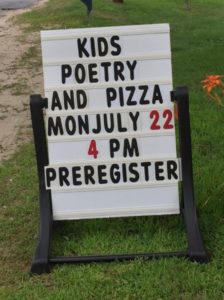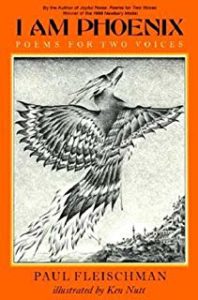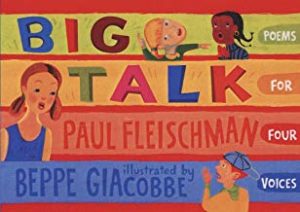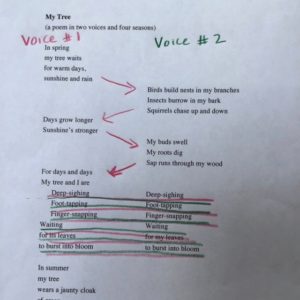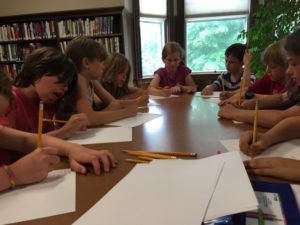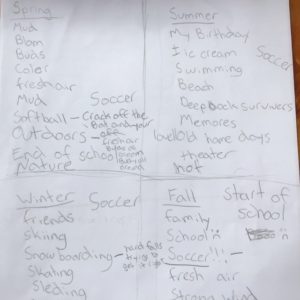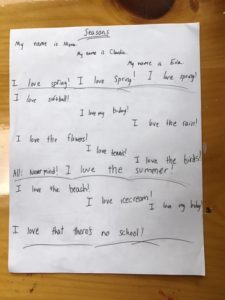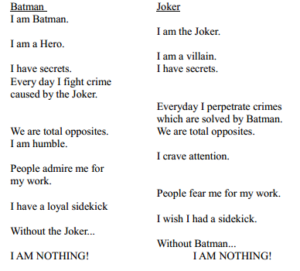One of the things that I love about summer writing workshops is that I can experiment with new workshop ideas to use when I visit schools and libraries during the school year.
I recently had an opportunity to do just that at the Charlotte Hobbs Library in Center Lovell, Maine.
Librarians there had the great idea to include pizza, most likely to entice kids away from swimming, exploring, and playing outside on a perfect summer’s day instead of going to the library to write poetry…
I’d discovered Two Voice Poetry many years ago from the work of Newbury Award winning poet and author Paul Fleishman.
I’ve written several on my own but had never used them for a workshop.
What is Two Voice Poetry? Two Voice Poems are poems written from two different points of view on the same topic. They’re also meant to be read aloud, which makes them especially fun for children to write and perform.
The poetry usually has two columns—one for each person who is reading the poem. One person reads from the left-hand column, the other from the right. If the poet wants the two readers to say something at the same time, the words can be written in both columns on the same line, or a third column can be added.
Here’s an example from Honeybees by Paul Fleishman:
Click Honeybees to download the rest of the poem.
Fleischman’s work inspired me to write my own poems for two voices. For example, My Tree.
Okay, back to Charlotte Hobbs. I’ll admit it—I freely experimented on my small group of 12 kids, ages 7-11. I didn’t have much of a plan, but I’ve come to trust myself, children, and the joy of playing with words. (and many years of “winging it” as a teacher…)
The Workshop (times are approximate)
Step One: (10 minutes)
I introduced the concept of poetry for two voices by asking kids to read some poems I’d printed out.
Honestly, at first, they didn’t really get it. The lines on the page, skipping back and forth, sometimes reading alone, sometimes together. It was confusing, and the form was new to them.
But it was summer! No pressure!
Luckily I had my colored pencils. I quickly color-coded and drew arrows and we were back in business.
Step Two: (10 minutes)
I suggested we write Two Voice poems organized around the seasons. I asked each kid to fold a piece of paper in four and fill each square (okay rectangle, I was corrected!) with what they loved to see, do, smell, hear for each season. It was quiet then, except for the lovely, rhythmic sound of pencils clicking on paper, which, as a poet, of course, I had to point out to them.
Step Three: (10 minutes)
When they ran out of ideas, I asked them to pair up (or triple up) and circle all the things they had in common for each season.
Then, because this is what I always do in my poetry workshops because I always do myself when I’m writing, I asked them to push themselves and each other to expand on their ideas. “What do you mean, soccer? What do you mean about trees changing color? What trees? What colors? What do you mean hot chocolate in winter? How does it smell? Taste? Give me some more words!!!!”
Step Four: (20 minutes)
With their partners, or trios, it was time to write the poems. If they were stuck or didn’t know where to start, I suggested they introduce themselves in the poems and start with spring.
Here’s an example from the beginning of rising second graders Ezra and Eliot’s poem:
Seasons
I am Ezra
I am Eliot
In spring In spring
I like I like
when the birds come back
playing baseball
We both like We both like
MUD! MUD!
The kids then dispersed themselves around the library—some writing in a corner on the floor, a group of three in a small meeting room, others at tables. Even though it was very hard for me, I decided to trust the process, not suggest or interrupt, and Leave. Them. Alone.
Even when the pizza arrived, they kept writing!
Step Five: (20 minutes)
Pizza and Poetry!
Apparently, writing made this group really hungry. Twelve kids devoured three pizzas while taking turns to share their poems. We even went overtime!
This is just the first page of five that three girls wrote and performed:
Final Thoughts
I made it a point not to Google Two Voice Poetry before the workshop. Whenever I do writing and poetry workshops with children of all ages, I want to be authentic. I feel we do our best work, at least initially, when we all come from a place of who we are without using outside influences. I trust and honor the creative process. Coming from my own authentic place, I connect more deeply and honestly with others.
That said, I later Googled away and found tons of information on the Internet. If this form is new to you as a teacher and you want to try it in your classroom, you might start by getting ideas off the Internet, but it’s better to immerse yourself by reading and writing on your own. Here’s a poem floating around on the web that might get you started.
Thank you for reading and please stay in touch!
